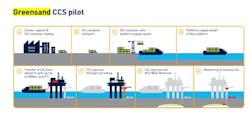Boost for North Sea CO2 storage project following Belgium/Denmark agreement
Offshore staff
VIRUM, Denmark — The governments of Belgium and Denmark have entered into an agreement that allows the carbon capture and storage Project Greensand to move forward.
This will permit captured CO2 to be shipped across their boarders for permanent subsurface storage in a sandstone reservoir 1,800 m beneath the Danish North Sea.
Trials are due to start later this year.
CO2, captured by INEOS from its plant at Zwijndrecht, can now be shipped via the port of Antwerp to the company’s Nini West oil platform 200 km off western Denmark in the North Sea, where it will be injected as a liquid into the former oil field.
According to the company, there is currently no captured CO2 in Denmark suitable for storage in connection with the demonstration phase of Greensand. But under the new agreement, it will be possible to transport captured CO2 from INEOS facilities in Belgium to Greensand's storage locations in the North Sea.
The project, led by INEOS and Wintershall Dea, is under development by a consortium of 23 companies, research centers, institutions and logistics groups, with an ambition of storing up to 8 MM metric tons per year of CO2 by 2030. It also has financial support from the Danish Energy Agency.
Trials will cover the entire supply chain for capture, transport and storage of CO2 permanently beneath the seabed; successful implementation could usher in large-scale CO2 storage.
The Siri trench off the Danish coast has been chosen for the pilot project because the seabed is very hard, with virtually no seismic activity recorded in the ground.
DNV GL has certified that the Nini West Field is suitable for injecting 450 MM metric tons per year per well over a 10-year period, and that the subsea reservoir can safely contain the CO2.
INEOS says the area has suitable reservoirs and scope for further development. If the pilot is successful, preparations should allow 1.5 MM metric tons of CO2 to be stored by 2025.
The storage capacity in the Siri area will then be further scaled up.
10.03.2022

